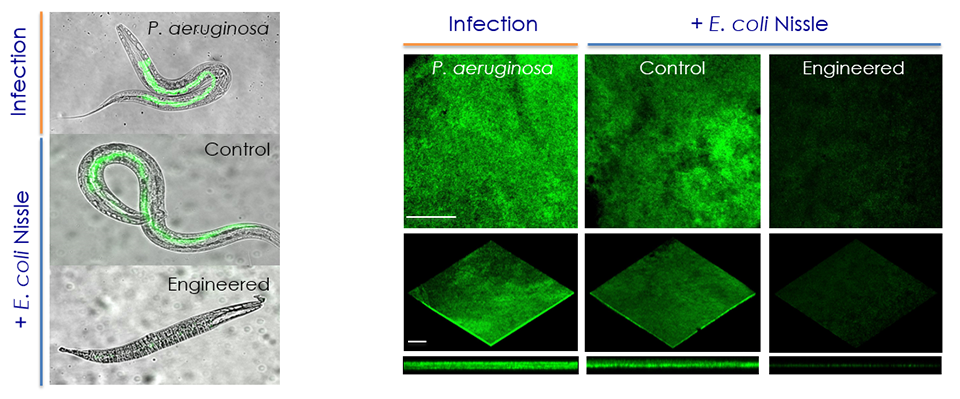In a new article published online in Nature Communications on 12 April 2017, Associate Professor Matthew Chang’s team has demonstrated for the first time that engineered probiotic E. coli bacteria can sense and kill disease-causing bacteria in the gut of animals.

Engineering “good” bacteria to kill their bad counterparts in preventing and treating gut infections
In a new article published online in Nature Communications on 12 April 2017, Associate Professor Matthew Chang’s team has demonstrated for the first time that engineered probiotic E. coli bacteria can sense and kill disease-causing bacteria in the gut of animals. The probiotic E.coli bacteria are originally derived from the human gut and considered “good” bacteria because of their ability to prevent inflammation and boost our immune response. The good bacteria can also prevent infection from disease-causing bacteria (“bad” bacteria) by crowding them out, thus stopping them from gaining a foothold in the gut.
Assoc Prof Chang’s team previously showed that an E. coli system which they had engineered could efficiently seek and kill Pseudomonas aeruginosa bacteria in cell culture. These Pseudomonas bacteria are multi-drug resistant pathogens because of their intrinsic antibiotic-resistant mechanisms and they are a major cause of hospital-acquired infections, increased mortality in gut-derived sepsis and bacteremia, and respiratory infections starting in the gut. They can also cause a condition called severe necrotising enterocolitis in premature infants, in which parts of the gut deteriorate and may even develop holes.
The reprogrammed E. coli killing system had several novel aspects. Firstly, the killing machines could sense the bad bacteria and move towards them. Next, sensing of the bad bacteria triggered the new killer cells to release a toxin that killed the target bacteria as well as an enzyme that broke down the bacteria biofilms. These are layers of bacteria built upon each other (like a bacteria layer cake). Bacteria encased in these biofilms are notoriously difficult to destroy with antibiotics. Not only could the novel system break down biofilms, it also killed the bacteria released afterwards and prevented new biofilms from forming. The experiments served as an important proof of principle, indicating that the system could be effective in organisms.
Now, A/Prof Chang’s laboratory has gone a step further and demonstrated that a similar engineered E. coli system can kill Pseudomonas aeruginosa bacteria in mice and in a worm called C. elegans. The engineered killer bacteria were effective at clearing an established Pseudomonas infection in the gut of infected mice, and could also prevent the bacteria from establishing an infection when administered as a prophylactic.
Interestingly, both the antibacterial toxin and biofilm-disrupting enzyme were needed for these effects. The reprogrammed E. coli killers were also effective at clearing Pseudomonas bacteria from C. elegans worms, prolonging their lifespan over infected worms that were not treated with the engineered bacteria. The clearance of the bad bacteria (which were modified to be fluorescent) could be seen through the transparent skin of the worms under a microscope, as the fluorescence disappeared after treatment.
Given these promising results in animal models, the next step would be to test the engineered seek-and-kill system in humans as a next-generation antibiotic strategy that would precisely target pathogens while minimising the damaging effect on the gut microbiota that is observed with broad-spectrum antibiotics. Such treatments may be very useful for reducing the incidence of multidrug-resistant bacterial infections, which represent an enormous healthcare challenge with few therapeutic options.
References
1. Hwang IY, Koh E, Wong A, et al. Engineered probiotic Escherichia coli can eliminate and prevent Pseudomonas aeruginosa gut infection in animal models. Nat Commun. 2017 Apr 12. [Epub ahead of print].
2. Hwang IY, Tan MH, Koh E, Ho CL, Poh CL, Chang MW. Programming microbes to be pathogen-seeking killers. ACS Synth Biol. 2014, 3(4) 228-237.

